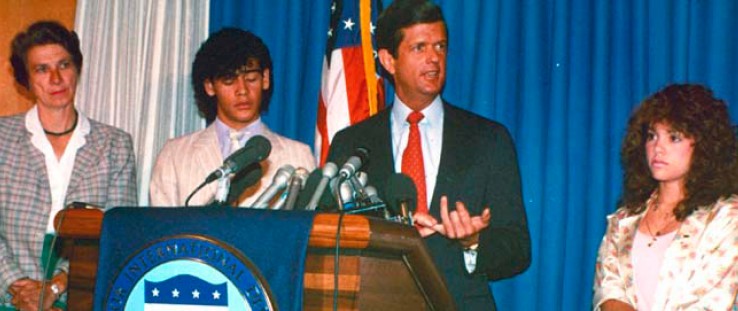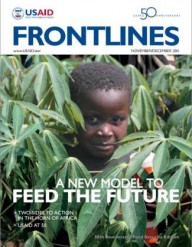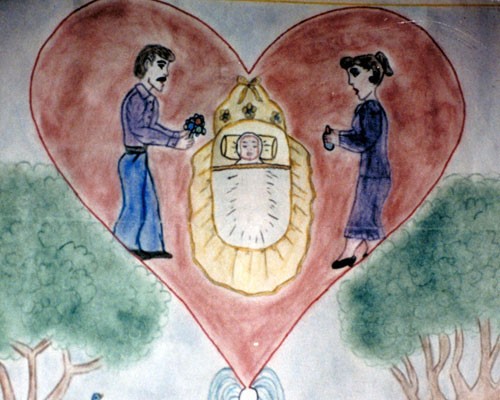 Representatives from the Center for Communication Programs and USAID speak alongside popular singers Tatiana and Johnny about the Pop Music and Sexual Responsibility project in Mexico.
Center For Communication Programs, 1986
Representatives from the Center for Communication Programs and USAID speak alongside popular singers Tatiana and Johnny about the Pop Music and Sexual Responsibility project in Mexico.
Center For Communication Programs, 1986
 Representatives from the Center for Communication Programs and USAID speak alongside popular singers Tatiana and Johnny about the Pop Music and Sexual Responsibility project in Mexico.
Center For Communication Programs, 1986
Representatives from the Center for Communication Programs and USAID speak alongside popular singers Tatiana and Johnny about the Pop Music and Sexual Responsibility project in Mexico.
Center For Communication Programs, 1986
In 1986, people in isolated villages across Latin America gathered around the few televisions in their communities to watch the world premiere of the Mexican music video for the song Cuando Estemos Juntos or “When We Are Together.”
The hit-single performed by Tatiana Palacios, a Mexican singer, and Johnny Lozada Correa of the Puerto Rican band Menudo, marked the start of a revolution in the use of media to educate on health subjects. “Their pop don’t preach exactly, but Tatiana and Johnny are putting out the word: be careful—with sex,” according to a People magazine article that year.
The song, infused with messages about adolescent sexual responsibility, was part of one of the first successful entertainment education (also known as edutainment) campaigns in the world. Edutainment is used by the media to educate people while entertaining them at the same time.
<>With USAID funding of $300,000 and technical support, the John Hopkins University’s Center for Communication Programs developed the campaign. The goal was to get Latin American teenagers and their parents talking openly about adolescent sexuality. Project staff wrote, recorded, and distributed two songs and music videos to promote family planning messages, with the help of a former RCA records executive. It came at the right moment when music videos were just becoming widely popular as MTV was launched in 1981.
“USAID took a risk to support the ground-breaking music video featuring Tatiana and Johnny singing about the issues kids face regarding sexuality, but it proved it a risk well worth taking. The campaign was a huge success and laid the groundwork for future entertainment education projects across the globe,” said Susan Krenn, director of the Center for Communication Programs. “Twenty-five years later it’s almost unheard of for a development effort not to include a social and behavioral communication component, and most feature some type of entertainment education. USAID’s Office of Population and Reproductive Health lead the way on this agenda in the ’80s.”
The campaign became one of the most widely discussed, award-winning social projects in the early history of development communication. More than 150 million people tuned in when the music video was launched on the popular TV show Siempre en Domingo. The campaign’s success was showcased at the first International Conference on Entertainment-Education and Social Change in 1989 and is still used today as a model for edutainment campaigns.
At the conference, Palacios spoke about how her interest in promoting the campaign’s message grew when she learned that half of all girls under 18 in many Latin American countries had been pregnant at least once.
“To those who say that young people never listen to lyrics, I can show you thousands of letters sent to me, to the radio stations, and to the youth centers commenting on the messages,” Palacios said. “The message in the songs was clear: you have to wait until you are mature enough, physically and mentally, before bringing children into this world.”
“When We Are Together…Wait”
For thousands of years people have been using entertainment through music and parables to communicate information. Development professionals quickly embraced the idea of using mass media and entertainment to educate as it was a cost-effective way to reach millions of people at a time. Media executives have helped with campaigns for opportunities to achieve commercial success and to promote positive messages. Back in the mid 1980s, the sex education songs “When We Are Together” and its flipside tune Détente, or “Wait,” aired repeatedly on radio and television stations across Latin America. Broadcasters also provided contact information for local youth centers or family planning clinics whenever the songs played.
At the peak of its popularity, Cuando Estemos Juntos could be heard over 20 times a day on Mexican radio and television stations. It remained number one on Mexican music charts for five weeks and made top-10 lists in 16 other countries. The performers appeared on talk shows, and the news media gave the project extensive—and free—coverage. Together, the songs, videos, television spots, and related publicity received more than 1 million hours of free airtime. Surveys following the campaign revealed that more than half of teens discussed the songs with their female friends and more than one-third talked about them with their mothers.
Milton Rojas Chavez was 12 when he heard the song on the radio in Chimbote, Peru. He remembers his mom sold posters of the singer Johnny Lozada Correa in the shop she ran out of their living room.
“I clearly remember this song because my aunt, who was in high school at the time, always sang along to it when it came on the radio,” Rojas Chavez said. “She would always tell me she loved the song not only because it had great rhythm but it also had a great message.”
The campaign’s approach has been replicated in other health and social areas such as substance abuse, gender equality, human trafficking, immunization, HIV/AIDS, malaria, and cancer. USAID continues to fund projects that use music, drama, comedy, and mass media to model and encourage positive changes in behavior.
For example, throughout Asia and the Pacific, the USAID-supported MTV EXIT campaign uses TV and concerts and other live events to help raise awareness about human trafficking.
USAID currently supports an MTV project in Kenya that uses mass media to educate young people on HIV awareness and prevention. Filmed in Nairobi, the MTV series Shuga portrays the lives of young adults as they confront the realities of love, substance abuse, and living with HIV. The project also has an online component that includes a blog where youth discuss a variety of health issues.
“The use of mass media and celebrities in sending out health messages continues to be very effective in reaching youth, which is vital as it is in adolescence that many choices are made that effect health outcomes for life,” said Gloria Coe, health communication adviser in USAID’s Office of Population and Reproductive Health. “With new technologies and the takeoff of social media, sites such as YouTube provide new platforms for entertainment education campaigns to reach a wider audience, across cultures.”
Mass media—in all forms—is significantly more accessible today in many places than it was 25 years ago. The 5th Entertainment Education Conference taking place in India in November will explore entertainment education innovations in the mobile technology and Internet-based gaming industry. But the intent remains the same—pull people in with high quality entertainment, while using important social messaging to catalyze the audience to reflect and act.











Comment
Make a general inquiry or suggest an improvement.